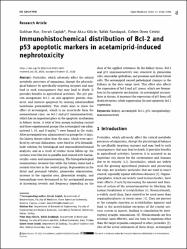| dc.contributor.author | Nur, Gökhan | |
| dc.contributor.author | Çaylak, Emrah | |
| dc.contributor.author | Kılıçle, Pınar Aksu | |
| dc.contributor.author | Sandayuk, Şafak | |
| dc.contributor.author | Çelebi, Özlem Önen | |
| dc.date.accessioned | 2022-12-20T05:59:39Z | |
| dc.date.available | 2022-12-20T05:59:39Z | |
| dc.date.issued | 2022 | en_US |
| dc.identifier.citation | Nur, G., Caylak, E., Kilicle, P.A., Sandayuk, S., Celebi, O.O. (2022). Immunohistochemical distribution of Bcl-2 and p53 apoptotic markers in acetamiprid-induced nephrotoxicity. Open Medicine (Poland), 17 (1), pp. 1788-1796.
https://doi.org/10.1515/med-2022-0603 | en_US |
| dc.identifier.uri | https://doi.org/10.1515/med-2022-0603 | |
| dc.identifier.uri | https://hdl.handle.net/20.500.12508/2435 | |
| dc.description.abstract | Pesticides, which adversely affect the critical metabolic processes of organisms, disrupt the physiological balance by specifically targeting enzymes and may lead to such consequences that may lead to death. It provides benefits in agricultural activities. The p53 protein antagonizes bcl-2, an anti-apoptotic protein character, and induces apoptosis by causing mitochondrial membrane permeability. This study aims to show the effect of acetamiprid, which is an insecticide from the neonicotinoid class, on bcl-2 and p53 immunoreactivity, which has an important place in the apoptotic mechanism in kidney tissue. A total of four groups including control and three experimental groups (the acetamiprid was administered 5, 10, and 15 mg kg-1) were formed in the study. After acetamiprid was administered via gavage for 14 days, the kidney tissues taken from the mice, which were sacrificed by cervical dislocation, were fixed in 10% formaldehyde solution for histological and immunohistochemical analyses, and as a result of routine tissue follow-up, the sections were blocked in paraffin and stained with haematoxylin-eosin and immunostaining. The histopathological examinations revealed that while the kidney tissue had a normal structure in the control group, degeneration in the distal and proximal tubules, glomerular degeneration, increase in the capsular area, glomerular atrophy, and haemorrhage were determined in the acetamiprid groups at increasing severity and frequency depending on the dose of the applied substance. In the kidney tissue, Bcl-2 and p53 immunoreactivity was observed in glomerular cells, sinusoidal epithelium, and proximal and distal tubule cells. The acetamiprid caused pathological changes in the kidneys in the dose range used. This effect also affects the expression of bcl-2 and p53 genes, which are biomarkers in the apoptotic mechanism. As acetamiprid accumulates in tissues, it increases the expression of p53 from cell death receptors, while suppressing the anti-apoptotic bcl-2 expression. | en_US |
| dc.language.iso | eng | en_US |
| dc.publisher | De Gruyter Open Ltd | en_US |
| dc.relation.isversionof | 10.1515/med-2022-0603 | en_US |
| dc.rights | info:eu-repo/semantics/openAccess | en_US |
| dc.subject | Acetamiprid | en_US |
| dc.subject | Bcl-2 | en_US |
| dc.subject | Histopathology | en_US |
| dc.subject | Immunoreactivity | en_US |
| dc.subject | Kidney | en_US |
| dc.subject | P53 | en_US |
| dc.subject.classification | Neonicotinoids | |
| dc.subject.classification | Imidacloprid | |
| dc.subject.classification | Nicotinic Receptors | |
| dc.subject.classification | General & Internal Medicine | |
| dc.subject.other | Acetamiprid | |
| dc.subject.other | Eosin | |
| dc.subject.other | Formaldehyde | |
| dc.subject.other | Hematoxylin | |
| dc.subject.other | Protein bcl 2 | |
| dc.subject.other | Protein p53 | |
| dc.subject.other | animal cell | |
| dc.subject.other | animal experiment | |
| dc.subject.other | animal tissue | |
| dc.subject.other | apoptosis | |
| dc.subject.other | Atrophy | |
| dc.subject.other | Bioaccumulation | |
| dc.subject.other | Controlled study | |
| dc.subject.other | Degeneration | |
| dc.subject.other | Distal tubule cell | |
| dc.subject.other | glomerulus | |
| dc.subject.other | histopathology | |
| dc.subject.other | immunohistochemistry | |
| dc.subject.other | immunoreactivity | |
| dc.subject.other | kidney capsule | |
| dc.subject.other | Kidney distal tubule | |
| dc.subject.other | Kidney epithelium | |
| dc.subject.other | Kidney hemorrhage | |
| dc.subject.other | Kidney proximal tubule | |
| dc.subject.other | Kidney tissue | |
| dc.subject.other | Nephrotoxicity | |
| dc.subject.other | Mouse | |
| dc.subject.other | Nonhuman | |
| dc.subject.other | Protein expression | |
| dc.subject.other | Proximal tubule cell | |
| dc.subject.other | Toxic dose | |
| dc.title | Immunohistochemical distribution of Bcl-2 and p53 apoptotic markers in acetamiprid-induced nephrotoxicity | en_US |
| dc.type | article | en_US |
| dc.relation.journal | Open Medicine (Poland) | en_US |
| dc.contributor.department | Mühendislik ve Doğa Bilimleri Fakültesi -- Biyomedikal Mühendisliği Bölümü | en_US |
| dc.identifier.volume | 17 | en_US |
| dc.identifier.issue | 1 | en_US |
| dc.identifier.startpage | 1788 | en_US |
| dc.identifier.endpage | 1796 | en_US |
| dc.relation.publicationcategory | Makale - Uluslararası Hakemli Dergi - Kurum Öğretim Elemanı | en_US |
| dc.contributor.isteauthor | Nur, Gökhan | |
| dc.relation.index | Web of Science - Scopus - PubMed | en_US |
















